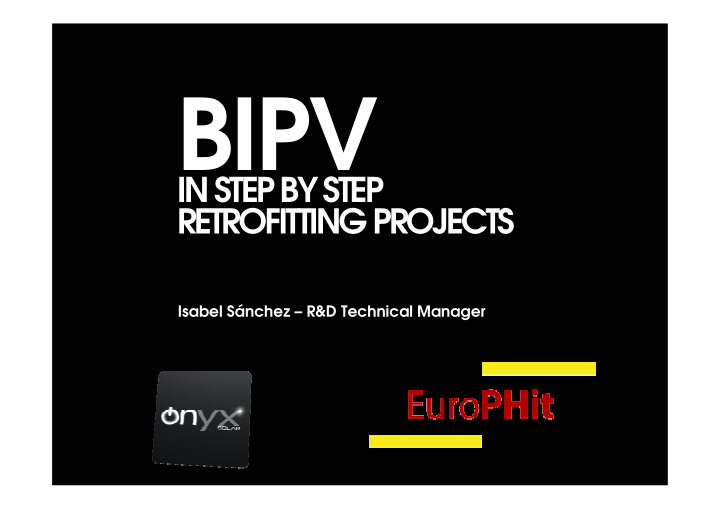



BIPV INSTEPBYSTEP RETROFITTINGPROJECTS Isabel Sánchez – R&D Technical Manager
1. WHAT IS BUILDING INTEGRATED PHOTOVOLTAICS (BIPV)? 2. BIPV SOLUTIONS 3. BIPV TECHNOLOGIES 4. PHOTOVOLTAIC VENTILATED FAÇADES 5. PHOTOVOLTAIC GLAZING AREAS 6. CONCLUSIONS
WHAT IS BUILDING INTEGRATED PHOTOVOLTAICS (BIPV)?
ACTIVE PASSIVE + PROPERTIES PROPERTIES [ PHOTOVOLTAICS]
BIPV SOLUTIONS
CURTAIN WALL BRISE SOLEIL WALKABLE FLOOR SKYLIGHT VENTILATED FAÇADE PARKING LOT CANOPY URBAN FURNITURE
Photovoltaic skylight
Photovoltaic skylight
Photovoltaic brise-soleil
Photovoltaic double skin
Photovoltaic ventilated facade
Photovoltaic walkable floor
Photovoltaic balcony railings
Photovoltaic canopy
Photovoltaic gallery
BIPV TECHNOLOGIES
crystalline amorphous sillicon
A-si technology Best results in terms of kWh/kWp under diffuse irradiation conditions • • Absorption of infrared and UV-radiation • Best aesthetic solutions when combining with other cladding materials. • Different see-through degrees
PHOTOVOLTAIC VENTILATED FAÇADES
PV ventilated façade system 1 3 4 2 1. Wall or support 5 2. Thermal insulation 3. Air chamber 4. Substructure 5. PV Cladding
PV ventilated façade system
Paslink test
Paslink test results. Madrid Madrid 3.5 3 2.5 Udin (W/m2K) 2 Conventional Wall 1.5 CW + Insu CW + Insu + VF Onyx 1 0.5 0 1 2 3 4 5 6 7 8 9 10 11 12 Month Base wall Base wall + ETICS Base wall + PV vent facade U value 2,21 0,52 0,51 (W/m 2 K)*
PV ventilated façade system Continuous insulation layer • Removal of humidity • Reduction of thermal transmittance • Acoustic insulation • Available space for hidden drainage systems, pipes or wiring • Easy installation - Simple maintenance works • Retrofitting: works do not disturb building´s users • Aesthetic value • + ENERGY PRODUCTION ON-SITE
PHOTOVOLTAIC GLAZING AREAS
PV glazing areas • Natural illumination • Absorption of the infrared and UV-radiation Reduction of heat gains in warm climate conditions • • Different see-through degrees • Visual relation between inner and outer space of buildings • Free energy production conventional glass a-si PV glass
PV glazing areas Sections of different glass configurations
PV glazing areas Opaque 10% transp. 20% transp. 30% transp. U value g value Power g value Power g value Power g value Power W/m 2 % W p /m 2 % W p /m 2 % W p /m 2 % W p /m 2 K . Single 5,2 23 62 29 44 32 39 37 33 (6+3.6+6) IGU (6+3.6+6/12 2,7 6 62 11 44 14 39 19 33 air/4+4) Low-E IGU (6+3.6+6/12 1,6 5 62 10 44 12 39 17 33 air /LowE4+4) Properties of a-si technology glazing areas
CONCLUSIONS
BIPV solutions replace conventional construction materials • Active and passive properties contribute to Passive House • certifications EnerPhit step by step projects should consider the implementation of • BIPV systems as a decision to be evaluated in the first steps of the plan
THANK YOU Isabel Sánchez – R&D Technical Manager isanchez@onyxsolar.com
Thank you for your attention www.europhit.eu The sole responsibility for the content of this presentation lies with the authors. It does not necessarily reflect the opinion of the European Union. Neither the EACI nor the European Commission are responsible for any use that may be made of the information contained therein. www.europhit.eu
Recommend
More recommend